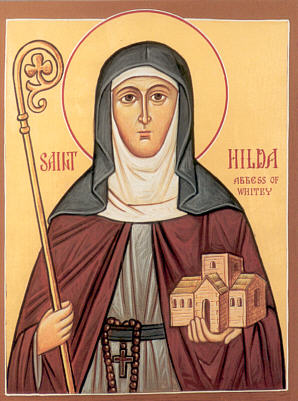|
|||
|---|---|---|---|
| This weekly bulletin insert complements the curriculum published by the Department of Christian Education of the Orthodox Church in America. This and many other Christian Education resources are available at http://dce.oca.org. | |||

St.Hilda, Abbess of Whitby, was born in 614 in Northumbria, at that time a kingdom which included northern England and part of southeastern Scotland. She was the grandniece of King Edwin, and it was not until her whole family became Christian, in 627, that she was baptized. Hilda loved being a Christian and spent hours reading Scripture, deeply moved by the compassion of Jesus Christ and by His call to service. After some years of effort to live the life she had discovered in the Bible, she decided to join her sister, who belonged to a monastery in France. But another well-known Christian convinced her to change her plans. Saint Aidan was an Irish monk and bishop who traveled across the land to teach about Jesus Christ. He asked Hilda to stay in Northumbria and help him. Though sorry not to join her sister, she obediently did as he asked. For a few years she lived as a monastic with a small group of women on the banks of the River Wear. Bishop Aidan then asked her to become abbess of a double monastery, with quarters for men and separate quarters for women, and a chapel in between. Bede in his "Ecclesiastical History" wrote about her work as abbess of this monastery in Hartlepool: "Hilda, the servant of Christ, being set over that monastery, began immediately to reduce all things to a regular system, according as she had been instructed by learned men; for Bishop Aidan, and other religious men that knew her and loved her, frequently visited and diligently instructed her, because of her innate wisdom and inclination to the service of God. " (Ecclesiastical History, Book 4, Chapter XXIII). It was after several years at Hartlepool that Hilda took on a bigger task: she became abbess of another and larger double monastery, this time in Whitby. Under her leadership it became the most famous center of learning in England. As always, Hilda strongly emphasized the study of Scripture. She actively recruited women and men to be students, mentoring them with love and patience. In 664, a momentous event, the Synod of Whitby, took place at the monastery. At this meeting the Church in Northumbria had to decide between the customs brought by Celtic missionaries like Saint Aidan, and those practiced in other areas as a result of the work of missionaries from Rome. Saint Hilda was a Celt, but when the Synod decided in favor of Roman practice, she became a peacemaker, urging everyone to accept the decision rather than fight it. Her own example of serene obedience, despite her disappointment at the Synod's outcome, influenced the bishops, priests, and royal rulers who deeply respected her. Saint Hilda was ill with a constant fever during the last years of her life, but she continued to teach and lead at the monastery. One student she nurtured was Caedmon, a simple cow herder who became England's first poet. Like many others, he regarded her as a spiritual mother and a true servant of God. |
|||
